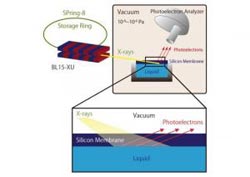World’s First Success in In Situ Tracking of Electrochemical Reactions at Solid/Liquid Interfaces by Photoelectron Spectroscopy

Layout of the In Situ XPS Measurement System<br>
National Institute for Materials Science (NIMS)
Japan Science and Technology Agency
A research group led by NIMS GREEN and JST, in collaboration with WPI-MANA and the Synchrotron X-ray Station at SPring-8, developed a new measurement system using high-energy X-rays of SPring-8 and a Si thin-membrane window. Through this achievement, the group succeeded for the first time in the world in tracking electrochemical reactions at solid/liquid interfaces in situ by X-ray photoelectron spectroscopy, which could only be used for measurement in a vacuum in the past.
A research group led by Prof. Dr. Kohei Uosaki, Research Manager of the Batteries and Fuel Cells Field at the Global Research Center for Environment and Energy based on Nanomaterials Science (GREEN) of the National Institute for Materials Science (NIMS) and Dr. Takuya Masuda, Researcher of the Precursory Research for Embryonic Science and Technology (PRESTO) program at the Japan Science and Technology Agency (JST), in collaboration with NIMS International Center for Materials Nanoarchitectonics (WPI-MANA) and the Synchrotron X-ray Station at SPring-8, developed a new measurement system using high-energy X-rays of SPring-8 and a silicon (Si) thin-membrane window. Through this achievement, the group succeeded for the first time in the world in tracking electrochemical reactions at solid/liquid interfaces in situ by X-ray photoelectron spectroscopy (XPS), which could only be used for measurement in a vacuum in the past.
A solid/liquid interface is an important part that converts and uses energy in familiar energy devices, such as fuel cells and solar cells. Recent research and development which aims to maximize the efficiency of energy use faces the need to break away from materials development dependent on empirical rules and to adopt clear evaluation methods that enable strategic materials design. Accordingly, there has been a strong desire for methods to directly observe and measure the dynamic behavior of reactions at solid/liquid interfaces in the environment where the reactions are taking place (in situ). Meanwhile, XPS is a method to investigate the surface species and oxidation states of the surface of a substance by irradiating the substance with X-rays and analyzing the energy of the photoelectrons emitted from the elements on the surface. Conventionally, XPS could only be used for measurement in a vacuum, and could not be used to directly observe the reactions at solid/liquid interfaces in situ.
The research group succeeded in observing the electrochemical reactions at a solid/liquid interface in a non-vacuum environment in situ by having high-energy synchrotron X-rays of SPring-8 penetrate through a thin Si membrane window with a thickness of 15 nm. Specifically, the group developed a measurement system that uses a thin Si membrane as a window for transmitting X-rays and photoelectrons, as a barrier separating a vacuum and a liquid, and as an electrode for electrochemical reactions, and uses the high-energy synchrotron X-rays of SPring-8 to detect, on the vacuum side (through the thin membrane), the photoelectrons that have been emitted at the interface between the thin Si membrane window (solid) and the liquid. With this system, the group succeeded in in situ observation of potential-induced Si oxide growth in water.
The research results are expected to further elucidate the process at solid/liquid interfaces of major energy devices such as rechargeable batteries and fuel cells. At the same time, they are expected to contribute to the development and better performance of important parts such as cell electrodes and catalyst materials as a result of clarifying the reaction mechanism and problems in existing materials. In particular, quantitative investigation of the composition and oxidation states of interfaces, which was difficult in the past, becomes possible, which helps illuminate the deterioration mechanism of electrodes and electrolytes through identification of side reactions and the products of the reactions. Also, since XPS has been used for materials design and development in diverse fields including the industrial field and the medical field, the research results are expected to contribute to elucidating the mechanism of a broad range of phenomena in which interface reactions play an important role in those fields.
This research was conducted as part of the “Program for Development of Environmental Technology using Nanotechnology” entrusted by the Ministry of Education, Culture, Sports, Science and Technology, and as part of the “Phase Interfaces for Highly Efficient Energy Utilization” research domain (Research Supervisor: Nobuhide Kasagi) of Individual Type Research (PRESTO) of the JST Strategic Basic Research Program, and the research results were published in the online preliminary edition of Applied Physics Letters, an applied physics journal published by the American Institute of Physics, at 3:00 a.m., September 13, 2013 (JST).
Media Contact
All latest news from the category: Materials Sciences
Materials management deals with the research, development, manufacturing and processing of raw and industrial materials. Key aspects here are biological and medical issues, which play an increasingly important role in this field.
innovations-report offers in-depth articles related to the development and application of materials and the structure and properties of new materials.
Newest articles

Superradiant atoms could push the boundaries of how precisely time can be measured
Superradiant atoms can help us measure time more precisely than ever. In a new study, researchers from the University of Copenhagen present a new method for measuring the time interval,…

Ion thermoelectric conversion devices for near room temperature
The electrode sheet of the thermoelectric device consists of ionic hydrogel, which is sandwiched between the electrodes to form, and the Prussian blue on the electrode undergoes a redox reaction…

Zap Energy achieves 37-million-degree temperatures in a compact device
New publication reports record electron temperatures for a small-scale, sheared-flow-stabilized Z-pinch fusion device. In the nine decades since humans first produced fusion reactions, only a few fusion technologies have demonstrated…





















